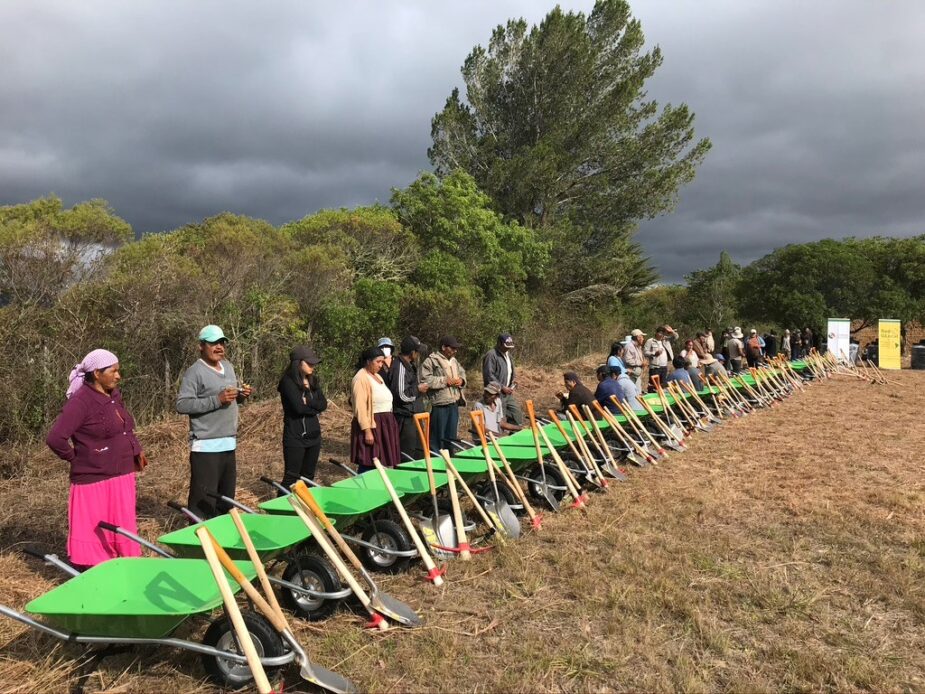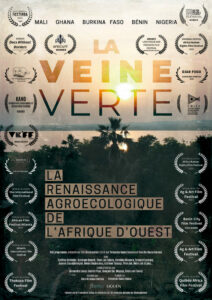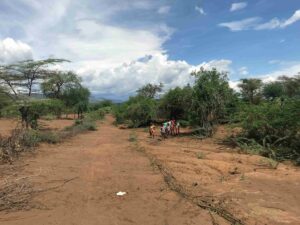
Food Academy: Testing sustainability in the system for small farms
The farmers of Kenya’s Makueni county know that the grain they grow travels far. A crop like the pigeon pea – “mbaazi” in Swahili – might start life on a smallholding in the country’s southeast, and end up on a dinner plate in India. It’s certainly a favourite among people who live along Kenya’s coast.
These farmers also know the demand has failed to bring in enough cash. What they didn’t know, was the root of the problem.
Food systems are complicated. A crop passes through many hands along its journey from farm to plate – a long, often invisible supply chain that involves different players like dealers, packers, transporters, processors, and the farmers themselves. Some of these players manage better than others to wrestle income out of the system, says Stellah Mukhovi, a senior lecturer at the Department of Geography and Environmental Studies at the University of Nairobi.
Too often, it’s smallholders who lose out. Mukhovi and her colleagues have come up with a method to pin down what stops them from reaping the benefits of their farm work and making it sustainable.
“The middlemen buy at the farmgate, export and get a lot of money, while farmers get very little”
Stellah Mukhovi, University of Nairobi
In Makueni, it turned out the bottleneck had nothing to do with productivity and everything to do with the business side of the process. “The middlemen are the ones who come to buy the product at the farmgate,” says Mukhovi. “And then they export it and get a lot of money, while the farmers get very little.”
Once the problem was clear, and with support from the research project – the Food Sustainability Assessment Framework (FoodSAF) – the farmers came up with a simple solution: they pooled the little money they had to help build a grain storage unit. The move put control back in their hands. “They are able to aggregate and therefore have more bargaining power as compared to if they are selling as an individual,” explains Mukhovi.
Keen that others benefit from the method that got to the core of the problem, the team has set out to spread the word through a Virtual Food Sustainability Academy, which just launched in parts of Africa and Latin America.
Holistic and participatory
The teachings at the Virtual Academy are founded on six years of work that began in 2015 in parts of Africa and in South America through the FoodSAF project, which slowly evolved into a transdisciplinary framework to assess any food system.
“What is unique is that it’s a holistic approach,” says Chinwe Ifejika Speranza, director of the Institute of Geography at the University of Bern in Switzerland, and a FoodSAF partner. “It helps to have a tool that can inform decision making at various levels.”
Theirframework of food sustainabilityhas five dimensions: food security, right to food, environmental performance, poverty and inequality, and social-ecological resilience. Anyone using the framework can look at multiple parts of a food system as a whole and identify weak links. “So not just looking at food security and forgetting about environmental performance of the food system,” explains Ifejika Speranza, “or only looking at environmental performance [and] forgetting about the dimension of right to food”.

Picture 1: Farmers in Makueni, Kenya, in the process of construction of the grain aggregation store. Credit: Stellah M. Mukhovi
By 2050, approximately 9 billion people will need to be fed nutritious food even as the resources to do so are depleting. But making complex food systems more sustainable is no easy feat. The team hopes that making their assessment tool widely available can be
a step in that direction.
The focus of the Academy is to shape what has been achieved through FoodSAF into a training programme, a new phase of the project funded by the r4d programme, a joint initiative by the Swiss Agency for Development and Cooperation and the Swiss National Science Foundation.
“The Academy is … to bring this framework to a larger community of practitioners and early-career personnel, either working in agriculture or NGOs, to be able to conduct participatory food sustainability assessments,” says Mukhovi.
The idea is to teach students the practicalities of how to carry out an assessment so that once they graduate from the Academy they can do this on their own, working with farmers and others involved in the food system. “Based on a simplified version of this framework, and adapted to their context, they could get to [analyse food systems],” says Ifejika Speranza. “Do we produce enough food? To what extent does it [the food system] consider environmental quality in the type of land management practices adopted?”

Picture 2: Five dimensions of food sustainability. Credit: FoodSAF project
When this assessment was done with the farmers of Makueni county, their ranking of the various framework components revealed a need to focus on inequality – and how the middlemen played a key role in the food system. A similar exercise in Laikipia, also in Kenya, led a group of dairy farmers to form a cooperative, build a cooler house, and install a milk cooling system. “They are able to bulk their milk, cool it, and sell it to whatever market they want instead of selling the milk through middlemen,” says Mukhovi. Similar participatory assessments have also been done in Nigeria, Ghana and Zambia.
Ifejika Speranza says the team designed the Academy so it can be adapted to each region’s needs. “The framework is the container,” she explains, “and within the container you have the sub containers of the five dimensions”. Each region then ‘fills up’ these sub containers according to the most pressing issues they face.
A knowledge dialogue
In Latin America, the project team is led by José Manuel Freddy Delgado Burgoa, Chair of the Board at the Andean-Amazon Pluricultural Community for Sustainability (COMPAS). Delgado says the team in Bolivia and Colombia has designed their course with equal focus on the five dimensions of the framework. It targets a range of learners: students in their last undergraduate year, postgraduate students studying food-related topics, university professors, and technical officers who work in municipalities.
“We are contributing something new, the food sustainability assessment, which didn’t exist here,” says Delgado. The project also aims to influence municipal and government policies on food sustainability, he adds, including Bolivia’s contribution to the forthcomingUN Food Systems Summit.

Picture 3: Apthapi, a traditional community meal, prepared in Tiwanaku, Bolivia, as part of a meeting between urban farmers from different parts of the country. Credit: Johanna Jacobi
For the past five years, COMPAS has been working on an assessment with the rural municipality Samaipata, where some farmers practise conventional agriculture and others agroecology. “Many times in communities, agroecological knowledge doesn’t yet exist,” says Delgado. Farmers rely on ancestral knowledge, he explains, having produced crops like quinoa for generations. “What we proposed throughout the course and [over] the years is an inter-scientific and knowledge dialogue (“dialogo de saberes”): we consider the academic knowledge and the indigenous knowledge at the same level.”
In Bolivia, Virtual Academy courses will be offered at two universities. And in Colombia, the training material developed by the Latin American team is extending its reach: researchers are working with the NGO Obosinga and the Regional Autonomous Corporation of the Department of Santander to replicate thecourse for technicians from 80 municipalities in the region of Cundinamarca.
“We consider academic and indigenous knowledge at the same level“
José Manuel Freddy Delgado Burgoa, COMPAS
Adaptability is a selling point for the training. “The modules I’ll have for university students will not be the same that I’ll use in the field to talk with extension officers or farmers,” says Ifejika Speranza, who is designing an online version of the course for students at the University of Bern in Switzerland.
The project has hit some unexpected hurdles along the way. Language is one: translating modules from Spanish to English, or vice versa, takes time. Connectivity has also been a challenge at times. Mukhovi says many potential students have had problems getting online to access the materials.
Despite the hiccups, the Academy launched in July 2021, with all course materials due to become available online by the end of the year. It also aims to grow its network beyond the African and Latin American universities already involved. The ultimate goal is to teach skills and knowledge that brings change in the food system, says Mukhovi. “They [students] will learn how to do the assessment, and how to support the farmers to come up with collective action.”
Related Posts
The Green Vein: Agroecology Rising in West Africa
WOMEN EMPOWERED: Vital Work Made Visible
Sources
Transformation Accelerating Initiative Towards Food Sustainability
Virtual Food Sustainability Academy (VFSA) at University of Nairobi and at University of Nigeria
RED GLOCAL Network for Food Sustainability and Inter-Scientific Dialogue in Latin America
Credit title picture: Credit:
COMPAS-Bolivia
About the authors:
Anita Makri is a freelance editor/writer/producer based in London, UK. Mukta Patil is a freelance journalist working in the US and India. She writes about energy, environment, and climate change.
Produced by:
Anita Makri and Mukta Patil (Translation by Elena Vardon)





